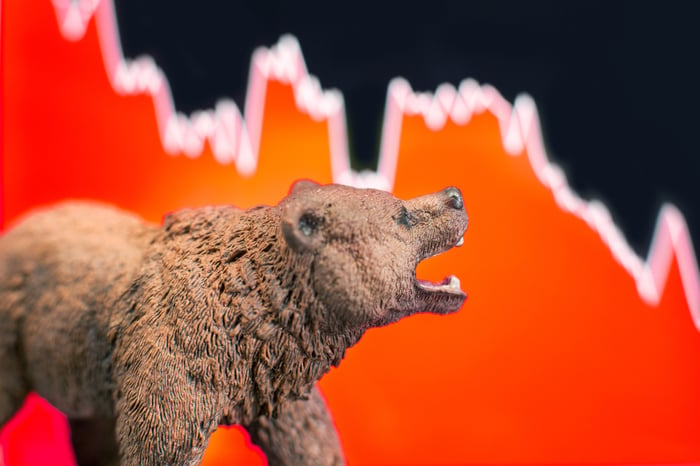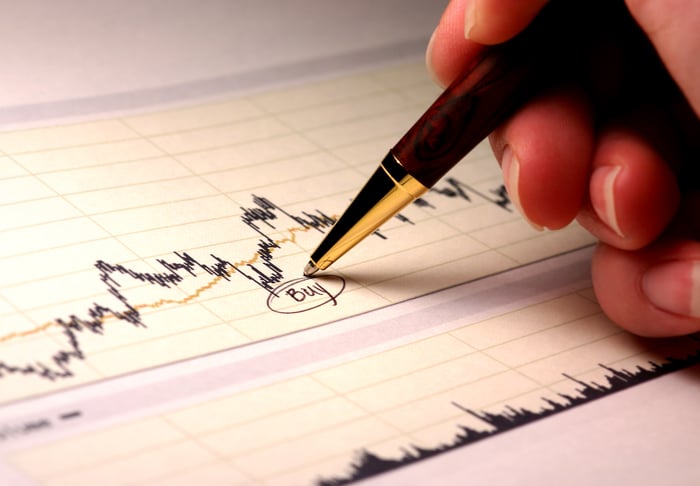March 9 is quickly becoming a day to remember for investors.
You see, 11 years ago, on March 9, 2009, the stock market would cement its lowest close during the Great Recession. Although there have been a number of hiccups and stock market corrections over the past 11 years, it has nonetheless remained a bull market.

Image source: Getty Images.
Then, yesterday, March 9, 2020, it happened. For the first time since 2008, Wall Street experienced what could be properly coined a "crash." I'm not a big fan of the overly dramatic, whereby media outlets call a 300-point drop in the Dow Jones Industrial Average (^DJI 0.58%) a "plunge," when in reality a 300-point decline equates to a little more than a 1% decline. But with all three major indexes registering one of their largest percentage losses in history, March 9, 2020, rightly deserves to be called a crash.
When the closing bell rang on Wall Street, the 123-year-old Dow Jones logged a 2,014-point drop, its largest in history, which equates to a 7.79% decline. This marked its 11th-steepest single-day decline, as well as the second biggest, in percentage terms, since 1987.
Meanwhile, the technology-heavy Nasdaq Composite (^IXIC -1.36%) and broader-based S&P 500 (^GSPC -0.48%) shed 625 points and 226 points, respectively, which blew their previous largest single-day point declines out of the water. On a percentage basis, the Nasdaq gave back 7.29%, its 10th-biggest percentage loss in history, whereas the S&P 500 gave up 7.6% for its 17th-largest percentage loss of all time.
Here's why the stock market crashed
Did we catch the license plate of the train that hit Wall Street, you ask? Well, look no further than growing fears over coronavirus disease 2019 (COVID-19) and the impact we're beginning to see it have on the global economy.
According to the World Health Organization's March 9 situation report, the world is closing in on 110,000 confirmed cases, which have led to over 3,800 deaths. What's particularly worrisome is that, while China's newly confirmed cases have slowed dramatically, new confirmations of the COVID-19 illness are surging in numerous countries around the globe. This includes Italy, which has taken the drastic step of putting the entire country on lockdown, as well as Iran, South Korea, and even the United States.

Image source: Getty Images.
Aside from the clear and obvious point that COVID-19 is a direct threat to the well-being of people around the world, it's also a threat to people's financial well-being. That's because this illness, and more importantly the uncertainty and fear surrounding COVID-19, has the ability to affect supply chains for most industries and sectors.
As an example, in the overnight session before the start of trading on Monday, March 9, West Texas Intermediate crude oil was down as much as 34%. This marked its worst single-day performance since the Gulf War in 1991. With IHS Markit forecasting a 3.8 million barrel-per-day drop-off in crude demand during the first quarter, the expectation was that OPEC and Russia (Russia isn't an OPEC member, but is nevertheless an important producer that's more or less been in line with OPEC's game plan) would aim to reduce global supply. But Russia didn't go along with the plan this time around, sparking a crude-pricing war between Saudi Arabia and Russia that sent oil plummeting.
The wash-out experienced yesterday in the oil and gas industry confirms that recession fears are running high.
Furthermore, some of the blame can be cast on margin calls. A quick look at the rout among gold-mining stocks, even as physical gold closed at a nearly seven-year high, demonstrates the likelihood that at least part of yesterday's record down day had to do with selling assets to cover margin calls.
Now that I've covered what caused yesterday's historic move in the markets, let's get down to the brass tacks of some things you really should know.

Image source: Getty Images.
The Fed can't save the stock market or U.S. economy from a recession
First of all, it is possible that we haven't seen the worst of this recent selling pressure. As much as we'd love for the longest economic expansion in U.S. history to continue, recessions are an inevitable part of the economic cycle.
What's more, no matter what the Federal Reserve does, it can't prevent the stock market from dipping into bear market territory, or stop the U.S. economy from entering a recession. While most downturns in the economy can be combated with lower lending rates, COVID-19 is an exogenous shock. In other words, the Fed can encourage businesses to borrow, but lower rates aren't going to do much good if consumers are too fearful to buy anything.
To be clear, I'm not saying COVID-19 will send the U.S. economy into recession or the stock market into bear territory. Rather, I'm pointing out that the Fed won't be able to do much of anything if the U.S. economy contracts from this illness and the fear associated with it.
Volatility is far more normal than you realize
I know I've pretty much beaten this dead horse into the ground over the past couple of weeks, but it's important to realize that volatility is a lot more common in the stock market than you might realize.
As investors, we've been spoiled by the relatively steady march higher in the market for years. Yet history shows that the S&P 500 loses at least 10% of its value (not rounded) every 1.85 years. Smaller corrections of say 5% are even more common.
Emotions drive short-term moves in the market
The reason stock market corrections and bear markets are so worrisome to investors is that upside moves are almost always driven by reason and operational earnings expansion in high-quality companies, while plunges are driven by emotions. These emotions can lead to some wild short-term swings in the stock market, but they're always outweighed over the long run by reason and operational earnings expansion.

Image source: Getty Images.
History says you're smart to buy any dip in the stock market
Maybe the most important thing you should know is that you'll look like a genius if you've bought into any of the previous corrections in the stock market.
Before the current correction, there have been 37 declines of at least 10% in the S&P 500 since the beginning of 1950. Each and every one of these drops, many of which lasted less than 3.5 months from peak to trough, were completely erased by a bull-market rally. It didn't matter whether you purchased stocks at the market's peak or got lucky enough to get in near the bottom of a correction -- you made money either way as long as you held on to your investments for the long run.
Also consider that there are countless companies you can consider buying right now that have been through numerous health scares, wars, recessions, and so on, but have come out stronger every time.
For example, healthcare conglomerate Johnson & Johnson (JNJ 0.95%) has been through thick and thin but has delivered 36 consecutive years of adjusted operating earnings growth and is likely to be on track to raise its dividend for the 58th year in a row in April. As a provider of high-margin pharmaceuticals and medical devices, Johnson & Johnson benefits from the fact that we don't get to choose when we get sick or what ailments we develop. This leads to a steady stream of cash flow in any economic environment. It's also a reason Johnson & Johnson is one of just two publicly traded companies with the highly coveted AAA credit rating.
Johnson & Johnson is just one example of dozens upon dozens of high-quality dividend stocks and high-growth names that should be minimally affected by COVID-19. If you buy high-quality businesses and give them the proper amount of time for your investment thesis to come to fruition, you'll probably be a very happy camper 10 years from now.





